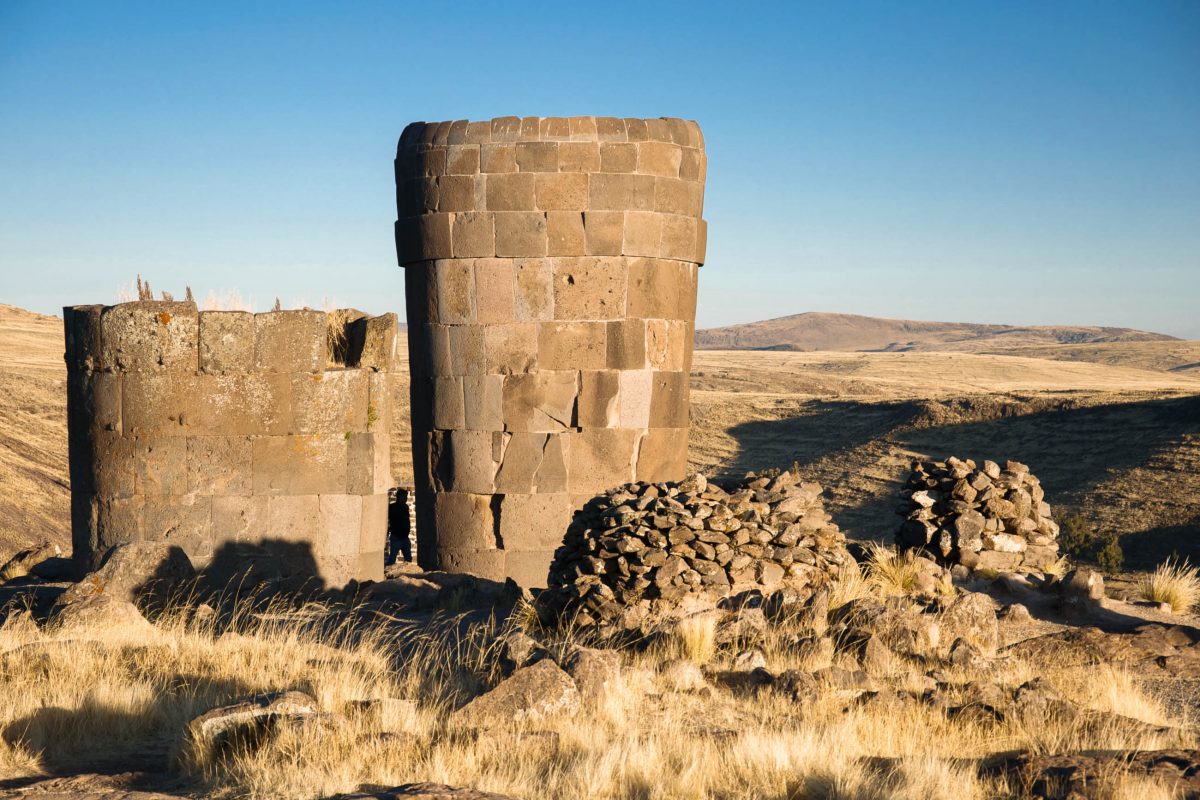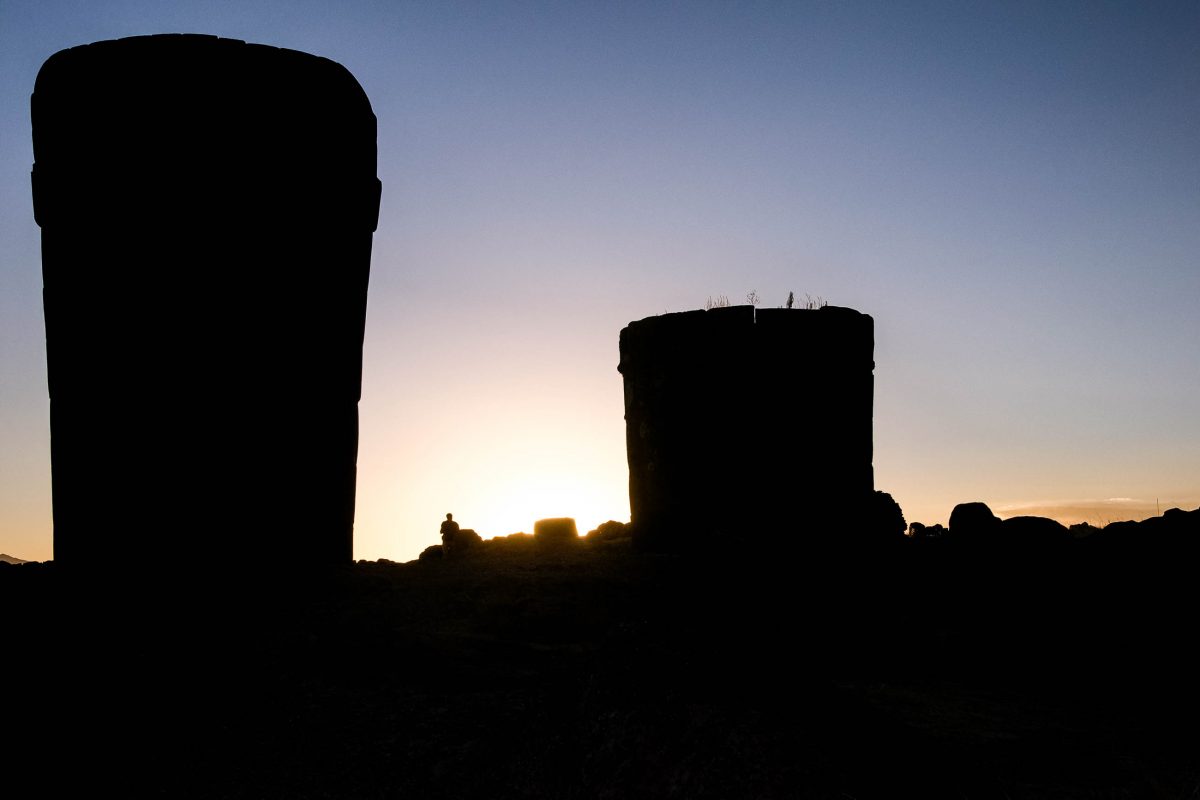Die Grabtürme von Sillustani gehören sicherlich zu den faszinierendsten Nicht-Inka-Sehenswürdigkeiten, die Peru zu bieten hat. Nicht weit vom Titicaca-See entfernt bestattete hier das Volk der Colla noch vor der Zeit der Inka ihre Könige in monumentalen Steintürmen.
Man kann sich die Verwunderung der spanischen Eroberer im 16. Jahrhundert vorstellen, als sie die Ufer des berühmten Lago Titicaca erkundeten. Da hauste die damalige Bevölkerung Perus in einfachen Hütten aus Lehmziegeln und Stroh und bauten für ihre Toten gewaltige Grabtürme aus Stein, die so genannten „Chullpas“. Die meterhohen, runden Begräbnisstätten sind in weiten Regionen in den Zentralanden anzutreffen.
Die eindrucksvollste Sammlung dieser Chullpas findet man bei Sillustani rund 30km nordwestlich von Puno am kleinen Umayo-See, der gleich neben dem Lago Titicaca liegt. Wann diese Grabstätten errichtet wurden, ist nicht genau bekannt, Forscher schätzen ihre Entstehung jedoch um etwa 1.000 nach Christus.
Inhaltsverzeichnis
BILDER: Grabtürme von Sillustani
Fotogalerie: Grabtürme von Sillustani
Grabstätten der Colla

Erbaut wurden die meterhohen Steintürme vom Stamm der Colla, einem Untervolk der Aymara am Titicaca-See, die im 15. Jahrhundert von den Inka erobert wurden. In den Chullpas wurden die sterblichen Überreste von Königen und anderen Würdenträgern begraben.
In Pflanzenfasern eingeschnürt wurden die Verstorbenen in fötaler Haltung auf ihre letzte Reise geschickt. Ihre Körper blieben aufgrund der trockenen und kalten Luft über Jahrhunderte erhalten. Oft wurden auch die Habseligkeiten des Verstorbenen, Nahrung für das Leben nach dem Tod und sogar Diener mit in die Chullpa eingemauert.
Besuch der Chullpas von Sillustani

Die Begräbnisstätte von Sillustani kann von Puno aus in etwa 30 Minuten per Bus oder Taxi über eine asphaltierte Straße erreicht werden. Die typischen Rundfahrten nach Sillustani dauern etwa 3,5 Stunden, von denen eineinhalb Stunden den Grabtürmen gewidmet sind.
Tipp: Der landschaftlich attraktive Lago Umayo ist einer der besten Plätze der Region, um Wasservögel zu beobachten. Auf einer kleinen Insel leben außerdem Vikunjas, die wildlebende Art der Alpacas.
Gigantische Gräber

Die zwölf Chullpas in Sillustani sind bis über zehn Meter hoch, meist rund und mit einer Steinplatte oder einem Strohdach gedeckt. Die älteren Chullpas sind noch aus kleinen Steinen und mit Lehm verkleidet, während die jüngeren aus perfekt ineinander gefügten, exakt rechteckigen Vulkansteinen bestehen. Die einzige Öffnung jedes Grabturms ist nach Osten gerichtet, in jene Richtung, wo jeden Morgen die Sonne aus der Erde wiedergeboren wird.
Obwohl die Grabtürme der Colla lange vor der Zeit der Inka erbaut wurden, ähneln sie in ihrer Bauweise sehr jenen berühmten Inka-Mauern, die man in Machu Picchu, Sacsayhuamán oder Ollantaytambo findet. Es wird vermutet, dass die Inka den Begräbniskult der Colla für ihre erdbebensicheren Bauten übernommen haben.
Die größte Chullpa in Sillustani ist die Chullpa de Legarto („Eidechsen-Chullpa“, so genannt aufgrund eines Reliefs in den oberen Steinen), mit 12 Metern der höchste Grabturm ganz Südamerikas.

Im Lauf der Jahrhunderte wurden viele der Grabtürme von Sillustani von Frost, Blitzschlag, Erdbeben oder Grabräubern beschädigt. Letzteren entging zum Glück der 4kg schwere Goldschatz, auf den erstaunte Archäologen im Jahr 1971 stießen.
Manche Grabtürme wurden auch einfach nie fertiggestellt. Bei einer Chullpa ist sogar noch die steinerne Rampe sichtbar, über die das Baumaterial an seinen Platz geschafft wurde.
Tipp: Am späten Nachmittag werden die Grabtürme von Sillustani von der niedrig stehenden Sonne in ein mystisches Licht getaucht – beste Voraussetzung für fantastische Erinnerungsfotos aber dafür auch die meisten Besucher.





